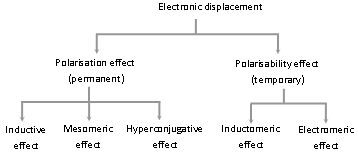Electronic displacement in covalent bonds
It is observed that most of the attacking reagents always possess either a positive or a negate -ve charge, therefore for a solution to operate on the covalent bond the latter must possess oppositely charged centres. This is made possible by displacement (partial or complete) of the bonding electrons. The electronic distance in turn can be due to certain effects, some of which are fixed and others are temporary. The former effects are permanently performing in the atom and are called as polarisation effects, while the latter are taken into play by the attacking reagent and as soon as the attacking reagent is replaced, the electronic distance disappears; such effects are known as the polarisability effects.

Email based Chemistry assignment help - homework help at Expertsmind
Are you searching chemistry expert for help with Electronic displacement in covalent bonds questions? Electronic displacement in covalent bonds topic is not easier to learn without external help? We at www.expertsmind.com offer finest service of Chemistry assignment help and chemistry homework help. Live tutors are available for 24x7 hours helping students in their Electronic displacement in covalent bonds related problems. We provide step by step Electronic displacement in covalent bonds question's answers with 100% plagiarism free content. We prepare quality content and notes for Electronic displacement in covalent bonds topic under chemistry theory and study material. These are avail for subscribed users and they can get advantages anytime.
Why Expertsmind for assignment help
- Higher degree holder and experienced experts network
- Punctuality and responsibility of work
- Quality solution with 100% plagiarism free answers
- Time on Delivery
- Privacy of information and details
- Excellence in solving chemistry queries in excels and word format.
- Best tutoring assistance 24x7 hours